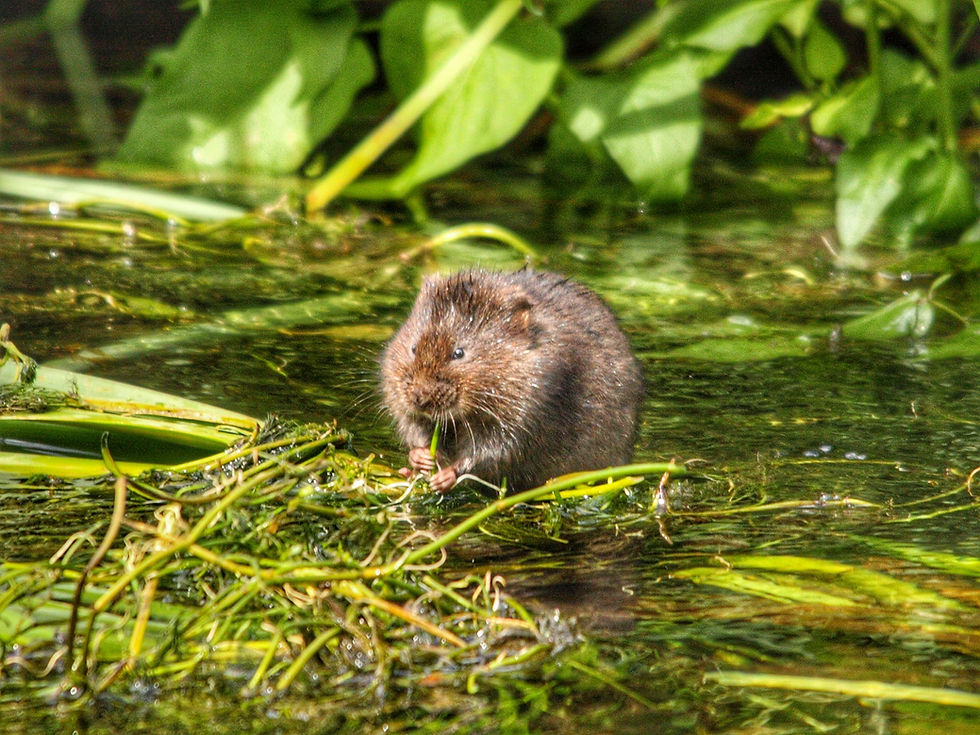The Perch: A Natural Jewel of the Norfolk Broads
- Duncan Holmes

- Mar 5, 2024
- 4 min read
The Norfolk Broads, a haven for remarkable wildlife, proudly hosts the European Perch (Perca fluviatilis) among its most captivating inhabitants. Beneath the surface of its waters, the perch emerges as a visual spectacle, its body a lush green canvas streaked with bold, dark vertical bars, and its fins a fiery red. More than just a feast for the eyes, the perch embodies the resilience and adaptability of freshwater fish. Despite facing near extinction in the Broads during the 1960s and 70s due to disease, the perch has made a remarkable recovery. Today, it thrives, particularly in the Broads, playing a vital role in maintaining ecological balance and enriching biodiversity.

The appearance of the perch is distinctive, with its vivid orangey-red pelvic and anal fins contrasting sharply against its body. The colour intensity of these features can vary with the water's clarity; in clear waters, the perch's hues are most striking, while in murkier environments, they appear more subdued. Atop the perch's back sits a spiky dorsal fin, a feature that demands careful handling due to its ability to prick the skin. The fish's gill covers and even its scales bear flattened spikes, giving the perch a rough texture distinct from the slippery feel of other fish.
As a visual predator, the perch's large eyes are not just a physical attribute but a hint at its predatory lifestyle, suggesting its adeptness at hunting in dim or turbid conditions. Although rarely active at night, perch will take advantage of the low light levels at the beginning and end of each day to hunt its prey.
The Perch's World Below
The life of a perch is a journey through a complex, underwater realm that many of us only glimpse from the banks. From the moment they hatch, perch are thrust into a world filled with both opportunity and peril. The reproductive cycle of the perch is a fascinating spectacle of nature, timed perfectly with the warming of spring waters. Males arrive first in the spawning grounds, displaying vibrant colours to attract females. The females, laden with eggs, select the most promising sites among aquatic vegetation to lay their adhesive egg strands, which can contain up to 300,000 eggs.
This prolific reproduction ensures the survival of the species, despite the many hazards young perch face in their early days. The early stages of life are a delicate dance, with fry hiding among aquatic plants, evading predators while feeding on microscopic organisms. As they grow, their world expands, and so does their diet, progressing to invertebrates and eventually other fish.

Perch are generally found around cover, decaying piling, overhanging trees and the Broads vast reedbeds are idea cover for the perch. Using its superb vision and sensitive lateral lines to detect movement, the perch makes short, swift dashes to capture prey.
For its size the perch has a large mouth, unusual in that it telescopes in 2 directions creating enormous vacuum that literally sucks its prey deep in to mouth. The Velcro like teeth on its jaws then secure its prey until it can be swallowed whole.

Although associated with cover the perch may venture into open waters in schools, using safety in numbers as a strategy to avoid larger predators. These schooling behaviours, more common in younger perch, become less frequent as they grow larger and more confident in their solitary hunting prowess.
The Challenge of Survival
Life for a perch in the Broads is not without its challenges. Predation from above and below—the sharp beaks of kingfishers and the silent approach of pike—requires constant vigilance. Otters and Herons will also eat the Perch despite it tough scales and spiky fins. Yet, the perch is not merely a prey item; it is a skilled predator, and its this role that has seen it thrive in the Broads.
For many years, the pike dominated the waters of the Broads as the apex predator, luring anglers worldwide with its notable size and quantity. The River Thurne system, in particular, was famed for yielding several record-breaking pike. However, the recent decline in pike numbers has led to an ecological shift, paving the way for the perch to step into the role previously held by the pike.

The Broads are now witnessing an unprecedented increase in the population of larger predatory perch, marking a significant change in the aquatic ecosystem not observed in living memory.
The rise of the perch in the Norfolk Broads exemplifies the ever-changing dynamics of natural habitats, showcasing the resilience of nature and its willingness to adapt.
The Broads Society's efforts in conservation, advocacy, and community engagement are essential to protecting this important part of our lives. Joining the Society is not just a way to support their efforts; it's an opportunity to be part of a community that is deeply committed to the stewardship of one of the UK's most precious natural landscapes. Whether you are a local resident, a frequent visitor, or someone who holds the Broads dear, becoming a member of the Broads Society is a meaningful way to contribute to the preservation and enhancement of this unique area.




Comments